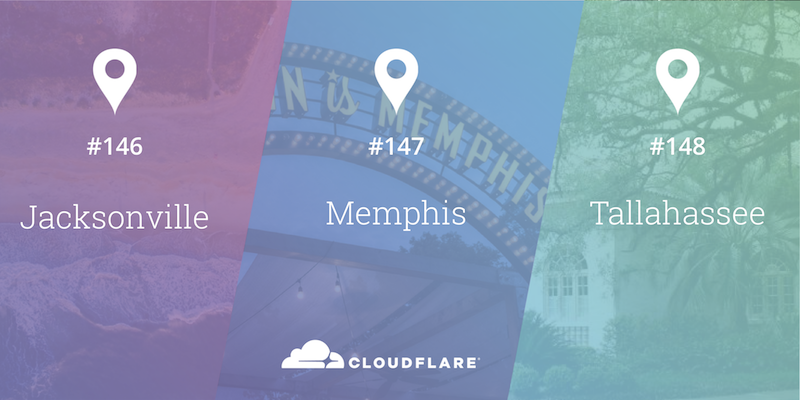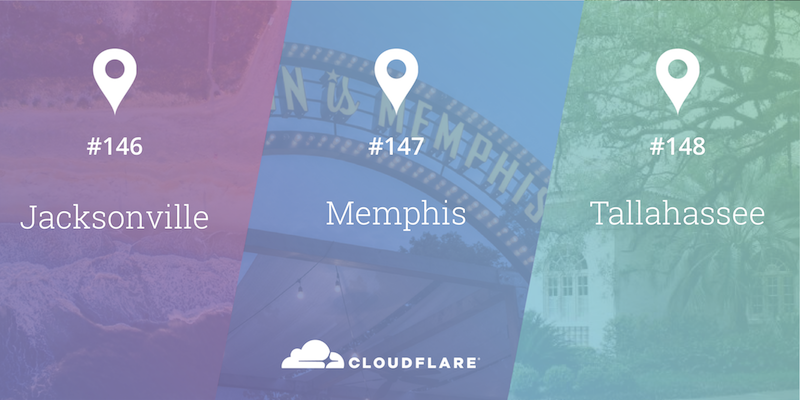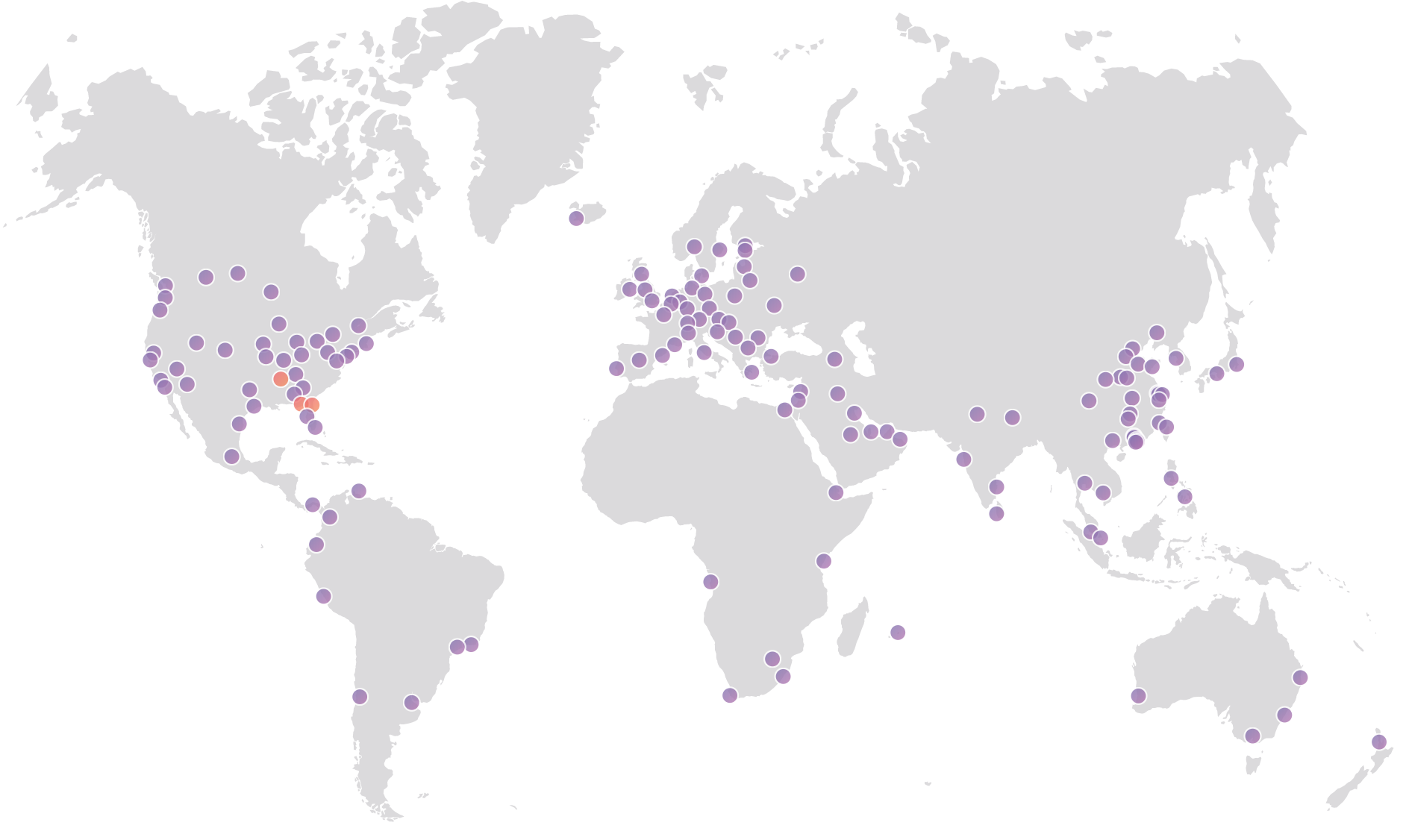Three more US data centers! Jacksonville, Memphis and Tallahassee


Good things come in threes! Following the launch of three data centers each in the Baltics (Riga, Tallinn, Vilnius) and in the Canadian Prairies (Calgary, Saskatoon, Winnipeg), we're thrilled to announce three new data centers in the Southern United States!
Located in Jacksonville (Florida), Memphis (Tennessee), and Tallahassee (Florida), they represent the 146th, 147th and 148th cities across our growing global network, and our 40th, 41st and 42nd cities just in North America. They join existing Cloudflare facilities in the US, including other Florida / Tennessee deployments such as Miami, Tampa and Nashville. Just in March, we've added deployments in 28 new cities worldwide, which help reduce latency to millions of Internet properties using Cloudflare, while expanding our capacity to withstand new and familiar attacks.
 Photo of Jacksonville Beach by Lance Asper / Unsplash
Photo of Jacksonville Beach by Lance Asper / Unsplash
Whether you're doing the Memphis Main Street Crawl, experiencing history through a visit to Tallahassee's Mission San Luis de Apalachee, or just relaxing by the stunning beaches of Jacksonville, you'll be close to the nearest Cloudflare data center.
The Cloudflare Global Anycast Network

This map reflects the network as of the publish date of this blog post. For the most up to date directory Continue reading
SPIFFE, SPIRE Join Cloud Native Computing Foundation Sandbox
 The open source workload identity framework projects are modeled after similar systems at Google, Netflix, and Twitter.
The open source workload identity framework projects are modeled after similar systems at Google, Netflix, and Twitter.
Vint Cerf Envies the Modern ‘Internet Adventure’ with Open Routing, Switching
 The disaggregation of the control plane and data plane with open interfaces feels a bit like the free-wheeling days of the early internet.
The disaggregation of the control plane and data plane with open interfaces feels a bit like the free-wheeling days of the early internet.
Cloudflare Arrives in the Canadian Prairies! Welcome Calgary, Saskatoon and Winnipeg


We just turned up Calgary, Saskatoon and Winnipeg - Cloudflare’s 143rd, 144th, and 145th data centers. This brings our Canadian presence to six cities, joining Toronto, Montreal and Vancouver. I grew up just outside of Saskatoon, so I couldn’t be happier that Cloudflare’s network has expanded to the Canadian Prairies. My parents still live there and I just booked flights to go and visit them this summer. When I tell people that I grew up in Saskatchewan, most people don’t know a lot about the region, so I wanted to share some of my favorite things about the region, starting from west to east:
- Calgary was home to the 1988 Winter Olympics and is a 90 minute drive from Banff, an incredible National Park that is absolutely worth visiting. Calgary has grown quickly over the last twenty years because of all the natural resources, including oil and gas. They host a famous rodeo, Calgary Stampede, for 10 days every summer. Definitely something to add to your bucket list. With Cloudflare’s new deployment in Calgary, we’ll make the Internet even faster for visitors. Hello Calgary!
-
About 1 million people live in the province of Saskatchewan. Saskatoon is the Continue reading
Rewind & recap: OCP Summit 2018
As you probably know, Cumulus Networks is an active contributor and enthusiastic member of the OCP community. So naturally, we couldn’t bear to miss OCP Summit 2018! The summit was held in San Jose from March 20th – 21st, and believe us, if you’re into open source anything, it was THE place to be. From BoF sessions to engineering workshops and everything in-between, there’s so much to talk about — but we’ll spare you an essay-length article and keep this short blog limited to our absolute favorite Cumulus OCP Summit highlights from the event. So whether you’re an OCP fan that couldn’t make it or you’re an attendee that wants to reminisce, check out these stellar moments from OCP Summit 2018.
Cumulus’ OCP projects
It was great to hear Omar Baldonado from Facebook give Backpack a shoutout during his keynote address. With the support of OCP, we’ve teamed up our OS with Celestica’s hardware to bring this project to fruition, and what better place to highlight this venture than at OCP Summit? As Baldonado points out, “Cumulus also has been a very long standing partner and contributor and driver within the OCP community,” and we intend to continue those efforts. Continue reading
Kathy Brown’s Op-Ed in the Hill Times: Canada’s Unique Opportunity to Lead the Future of the Internet
Kathy Brown, CEO of the Internet Society, recently penned an Op-Ed for Canada’s the Hill Times calling for a multistakeholder approach to Internet governance: “an approach that is collaborative, one that engages the entire Internet community.” According to Brown, “The time has come to expand this inclusive model of governance to more places around the world.”
“No one party, government, corporation, or non-profit controls the Internet and we are all better for it. Nor does any one party have the knowledge or the ability to identify the solutions to these complex policy challenges. It has been this approach—what we call the multistakeholder model—that has allowed humankind’s most advanced and powerful communications tool to spread so far and so fast.”
She cites the partnership between the Internet Society, Innovation, Science and Economic Development, the Canadian Internet Registration Authority, CANARIE, and CIPPIC as an example of the multistakeholder approach working successfully. “[Canada] is addressing cybersecurity head-on by working with the Internet Society to engage the Canadian Internet community in a process to develop recommendations to secure the Internet of Things.”
Read the entire Op-Ed, then learn how you can participate in the Collaborative Governance Project, Continue reading
Kubernetes Development Remains Hot, But What’s Next?
 The latest update showed continued maturation, but enterprises, developers, and vendors are still struggling to adapt.
The latest update showed continued maturation, but enterprises, developers, and vendors are still struggling to adapt.
2018 Next Gen Data Center Networking Report Available Now
 Download now to learn the latest on the Next-Generation Data Center market.
Download now to learn the latest on the Next-Generation Data Center market.
Australian Macquarie Telecom Rolls Out SD-WAN for Aged Care Provider
 The SD-WAN network will connect more than 20 Hall and Prior nursing home locations in Western Australia and New South Wales.
The SD-WAN network will connect more than 20 Hall and Prior nursing home locations in Western Australia and New South Wales.
VMware Boosts Cloud Management Automation, Promises Azure Support Soon
 VMware added new cloud management automation capabilities to its data center software and said Microsoft Azure support is “very near.”
VMware added new cloud management automation capabilities to its data center software and said Microsoft Azure support is “very near.”
Hybrid Cloud Security 101: What IT Leaders Need to Know
 Hybrid cloud environments present a revolutionary change in how organizations store and manage their data. But what happens if access to the cloud is compromised or interrupted?
Hybrid cloud environments present a revolutionary change in how organizations store and manage their data. But what happens if access to the cloud is compromised or interrupted?
Docker CTO Solomon Hykes Will Leave the Company He Co-Founded
 Hykes said the reason behind the move is because Docker Inc.’s current business requires a CTO with decades of experience shipping and supporting software.
Hykes said the reason behind the move is because Docker Inc.’s current business requires a CTO with decades of experience shipping and supporting software.
Nokia Will Slash 353 Jobs in Network, Technology Units
 Nokia total revenues dipped 1 percent to $8.3 billion in the fourth quarter of 2017.
Nokia total revenues dipped 1 percent to $8.3 billion in the fourth quarter of 2017.
